Yongzhen Huang
GaitSnippet: Gait Recognition Beyond Unordered Sets and Ordered Sequences
Aug 11, 2025Abstract:Recent advancements in gait recognition have significantly enhanced performance by treating silhouettes as either an unordered set or an ordered sequence. However, both set-based and sequence-based approaches exhibit notable limitations. Specifically, set-based methods tend to overlook short-range temporal context for individual frames, while sequence-based methods struggle to capture long-range temporal dependencies effectively. To address these challenges, we draw inspiration from human identification and propose a new perspective that conceptualizes human gait as a composition of individualized actions. Each action is represented by a series of frames, randomly selected from a continuous segment of the sequence, which we term a snippet. Fundamentally, the collection of snippets for a given sequence enables the incorporation of multi-scale temporal context, facilitating more comprehensive gait feature learning. Moreover, we introduce a non-trivial solution for snippet-based gait recognition, focusing on Snippet Sampling and Snippet Modeling as key components. Extensive experiments on four widely-used gait datasets validate the effectiveness of our proposed approach and, more importantly, highlight the potential of gait snippets. For instance, our method achieves the rank-1 accuracy of 77.5% on Gait3D and 81.7% on GREW using a 2D convolution-based backbone.
OmniDiff: A Comprehensive Benchmark for Fine-grained Image Difference Captioning
Mar 14, 2025Abstract:Image Difference Captioning (IDC) aims to generate natural language descriptions of subtle differences between image pairs, requiring both precise visual change localization and coherent semantic expression. Despite recent advancements, existing datasets often lack breadth and depth, limiting their applicability in complex and dynamic environments: (1) from a breadth perspective, current datasets are constrained to limited variations of objects in specific scenes, and (2) from a depth perspective, prior benchmarks often provide overly simplistic descriptions. To address these challenges, we introduce OmniDiff, a comprehensive dataset comprising 324 diverse scenarios-spanning real-world complex environments and 3D synthetic settings-with fine-grained human annotations averaging 60 words in length and covering 12 distinct change types. Building on this foundation, we propose M$^3$Diff, a MultiModal large language model enhanced by a plug-and-play Multi-scale Differential Perception (MDP) module. This module improves the model's ability to accurately identify and describe inter-image differences while maintaining the foundational model's generalization capabilities. With the addition of the OmniDiff dataset, M$^3$Diff achieves state-of-the-art performance across multiple benchmarks, including Spot-the-Diff, IEdit, CLEVR-Change, CLEVR-DC, and OmniDiff, demonstrating significant improvements in cross-scenario difference recognition accuracy compared to existing methods. The dataset, code, and models will be made publicly available to support further research.
Artificial Immune System of Secure Face Recognition Against Adversarial Attacks
Jun 26, 2024Abstract:Insect production for food and feed presents a promising supplement to ensure food safety and address the adverse impacts of agriculture on climate and environment in the future. However, optimisation is required for insect production to realise its full potential. This can be by targeted improvement of traits of interest through selective breeding, an approach which has so far been underexplored and underutilised in insect farming. Here we present a comprehensive review of the selective breeding framework in the context of insect production. We systematically evaluate adjustments of selective breeding techniques to the realm of insects and highlight the essential components integral to the breeding process. The discussion covers every step of a conventional breeding scheme, such as formulation of breeding objectives, phenotyping, estimation of genetic parameters and breeding values, selection of appropriate breeding strategies, and mitigation of issues associated with genetic diversity depletion and inbreeding. This review combines knowledge from diverse disciplines, bridging the gap between animal breeding, quantitative genetics, evolutionary biology, and entomology, offering an integrated view of the insect breeding research area and uniting knowledge which has previously remained scattered across diverse fields of expertise.
OpenGait: A Comprehensive Benchmark Study for Gait Recognition towards Better Practicality
May 15, 2024
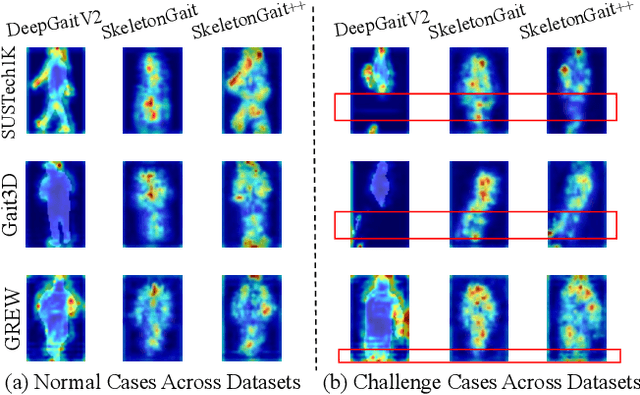

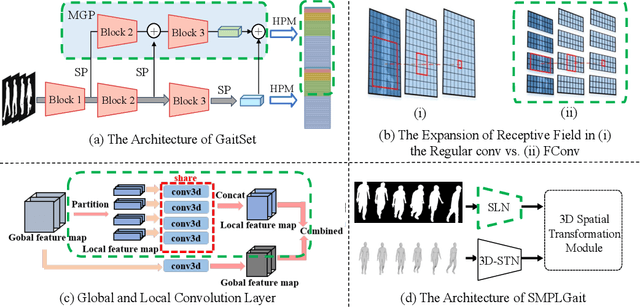
Abstract:Gait recognition, a rapidly advancing vision technology for person identification from a distance, has made significant strides in indoor settings. However, evidence suggests that existing methods often yield unsatisfactory results when applied to newly released real-world gait datasets. Furthermore, conclusions drawn from indoor gait datasets may not easily generalize to outdoor ones. Therefore, the primary goal of this work is to present a comprehensive benchmark study aimed at improving practicality rather than solely focusing on enhancing performance. To this end, we first develop OpenGait, a flexible and efficient gait recognition platform. Using OpenGait as a foundation, we conduct in-depth ablation experiments to revisit recent developments in gait recognition. Surprisingly, we detect some imperfect parts of certain prior methods thereby resulting in several critical yet undiscovered insights. Inspired by these findings, we develop three structurally simple yet empirically powerful and practically robust baseline models, i.e., DeepGaitV2, SkeletonGait, and SkeletonGait++, respectively representing the appearance-based, model-based, and multi-modal methodology for gait pattern description. Beyond achieving SoTA performances, more importantly, our careful exploration sheds new light on the modeling experience of deep gait models, the representational capacity of typical gait modalities, and so on. We hope this work can inspire further research and application of gait recognition towards better practicality. The code is available at https://github.com/ShiqiYu/OpenGait.
POPDG: Popular 3D Dance Generation with PopDanceSet
May 06, 2024Abstract:Generating dances that are both lifelike and well-aligned with music continues to be a challenging task in the cross-modal domain. This paper introduces PopDanceSet, the first dataset tailored to the preferences of young audiences, enabling the generation of aesthetically oriented dances. And it surpasses the AIST++ dataset in music genre diversity and the intricacy and depth of dance movements. Moreover, the proposed POPDG model within the iDDPM framework enhances dance diversity and, through the Space Augmentation Algorithm, strengthens spatial physical connections between human body joints, ensuring that increased diversity does not compromise generation quality. A streamlined Alignment Module is also designed to improve the temporal alignment between dance and music. Extensive experiments show that POPDG achieves SOTA results on two datasets. Furthermore, the paper also expands on current evaluation metrics. The dataset and code are available at https://github.com/Luke-Luo1/POPDG.
Disentangled Diffusion-Based 3D Human Pose Estimation with Hierarchical Spatial and Temporal Denoiser
Mar 07, 2024



Abstract:Recently, diffusion-based methods for monocular 3D human pose estimation have achieved state-of-the-art (SOTA) performance by directly regressing the 3D joint coordinates from the 2D pose sequence. Although some methods decompose the task into bone length and bone direction prediction based on the human anatomical skeleton to explicitly incorporate more human body prior constraints, the performance of these methods is significantly lower than that of the SOTA diffusion-based methods. This can be attributed to the tree structure of the human skeleton. Direct application of the disentangled method could amplify the accumulation of hierarchical errors, propagating through each hierarchy. Meanwhile, the hierarchical information has not been fully explored by the previous methods. To address these problems, a Disentangled Diffusion-based 3D Human Pose Estimation method with Hierarchical Spatial and Temporal Denoiser is proposed, termed DDHPose. In our approach: (1) We disentangle the 3D pose and diffuse the bone length and bone direction during the forward process of the diffusion model to effectively model the human pose prior. A disentanglement loss is proposed to supervise diffusion model learning. (2) For the reverse process, we propose Hierarchical Spatial and Temporal Denoiser (HSTDenoiser) to improve the hierarchical modeling of each joint. Our HSTDenoiser comprises two components: the Hierarchical-Related Spatial Transformer (HRST) and the Hierarchical-Related Temporal Transformer (HRTT). HRST exploits joint spatial information and the influence of the parent joint on each joint for spatial modeling, while HRTT utilizes information from both the joint and its hierarchical adjacent joints to explore the hierarchical temporal correlations among joints.
QAGait: Revisit Gait Recognition from a Quality Perspective
Jan 24, 2024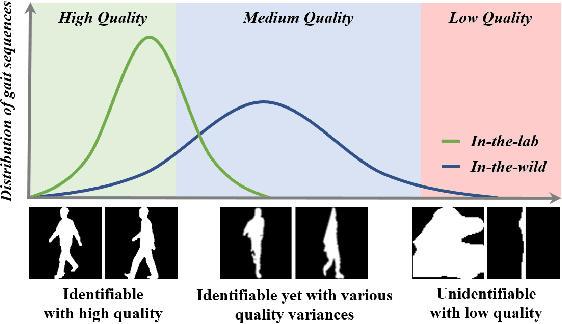
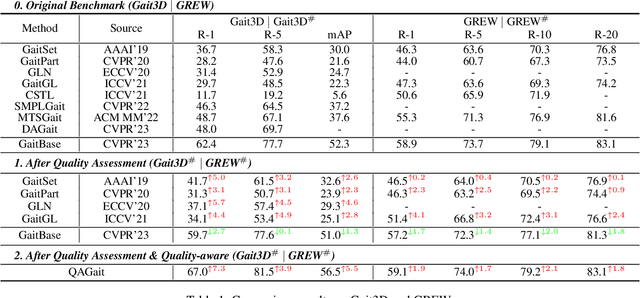

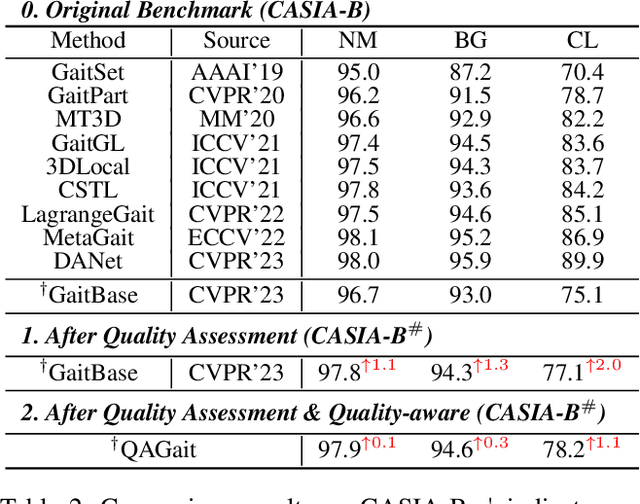
Abstract:Gait recognition is a promising biometric method that aims to identify pedestrians from their unique walking patterns. Silhouette modality, renowned for its easy acquisition, simple structure, sparse representation, and convenient modeling, has been widely employed in controlled in-the-lab research. However, as gait recognition rapidly advances from in-the-lab to in-the-wild scenarios, various conditions raise significant challenges for silhouette modality, including 1) unidentifiable low-quality silhouettes (abnormal segmentation, severe occlusion, or even non-human shape), and 2) identifiable but challenging silhouettes (background noise, non-standard posture, slight occlusion). To address these challenges, we revisit gait recognition pipeline and approach gait recognition from a quality perspective, namely QAGait. Specifically, we propose a series of cost-effective quality assessment strategies, including Maxmial Connect Area and Template Match to eliminate background noises and unidentifiable silhouettes, Alignment strategy to handle non-standard postures. We also propose two quality-aware loss functions to integrate silhouette quality into optimization within the embedding space. Extensive experiments demonstrate our QAGait can guarantee both gait reliability and performance enhancement. Furthermore, our quality assessment strategies can seamlessly integrate with existing gait datasets, showcasing our superiority. Code is available at https://github.com/wzb-bupt/QAGait.
Towards More Efficient Depression Risk Recognition via Gait
Oct 10, 2023



Abstract:Depression, a highly prevalent mental illness, affects over 280 million individuals worldwide. Early detection and timely intervention are crucial for promoting remission, preventing relapse, and alleviating the emotional and financial burdens associated with depression. However, patients with depression often go undiagnosed in the primary care setting. Unlike many physiological illnesses, depression lacks objective indicators for recognizing depression risk, and existing methods for depression risk recognition are time-consuming and often encounter a shortage of trained medical professionals. The correlation between gait and depression risk has been empirically established. Gait can serve as a promising objective biomarker, offering the advantage of efficient and convenient data collection. However, current methods for recognizing depression risk based on gait have only been validated on small, private datasets, lacking large-scale publicly available datasets for research purposes. Additionally, these methods are primarily limited to hand-crafted approaches. Gait is a complex form of motion, and hand-crafted gait features often only capture a fraction of the intricate associations between gait and depression risk. Therefore, this study first constructs a large-scale gait database, encompassing over 1,200 individuals, 40,000 gait sequences, and covering six perspectives and three types of attire. Two commonly used psychological scales are provided as depression risk annotations. Subsequently, a deep learning-based depression risk recognition model is proposed, overcoming the limitations of hand-crafted approaches. Through experiments conducted on the constructed large-scale database, the effectiveness of the proposed method is validated, and numerous instructive insights are presented in the paper, highlighting the significant potential of gait-based depression risk recognition.
FastPoseGait: A Toolbox and Benchmark for Efficient Pose-based Gait Recognition
Sep 02, 2023Abstract:We present FastPoseGait, an open-source toolbox for pose-based gait recognition based on PyTorch. Our toolbox supports a set of cutting-edge pose-based gait recognition algorithms and a variety of related benchmarks. Unlike other pose-based projects that focus on a single algorithm, FastPoseGait integrates several state-of-the-art (SOTA) algorithms under a unified framework, incorporating both the latest advancements and best practices to ease the comparison of effectiveness and efficiency. In addition, to promote future research on pose-based gait recognition, we provide numerous pre-trained models and detailed benchmark results, which offer valuable insights and serve as a reference for further investigations. By leveraging the highly modular structure and diverse methods offered by FastPoseGait, researchers can quickly delve into pose-based gait recognition and promote development in the field. In this paper, we outline various features of this toolbox, aiming that our toolbox and benchmarks can further foster collaboration, facilitate reproducibility, and encourage the development of innovative algorithms for pose-based gait recognition. FastPoseGait is available at https://github.com//BNU-IVC/FastPoseGait and is actively maintained. We will continue updating this report as we add new features.
Free Lunch for Gait Recognition: A Novel Relation Descriptor
Aug 28, 2023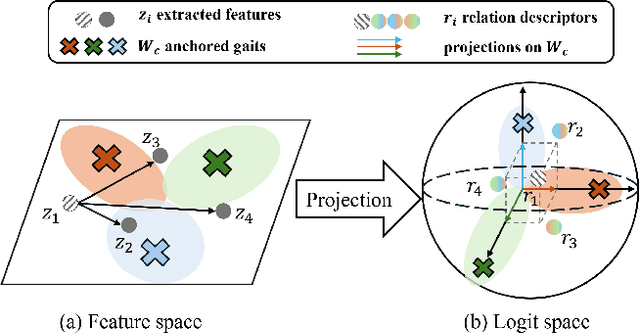
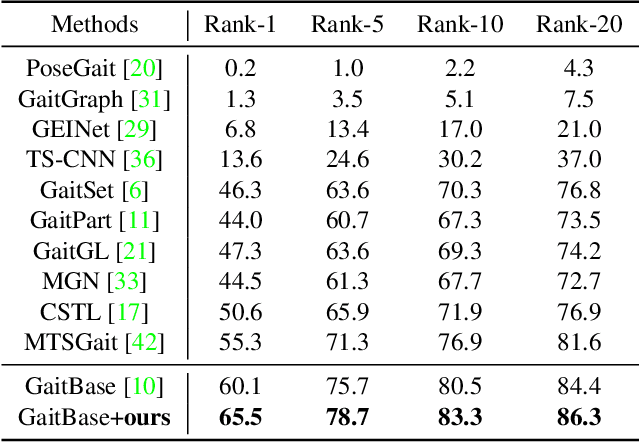
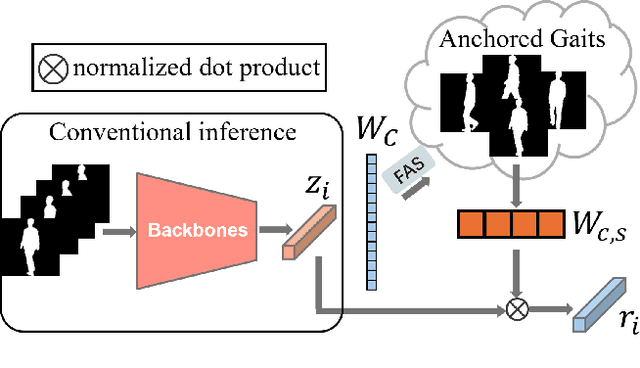
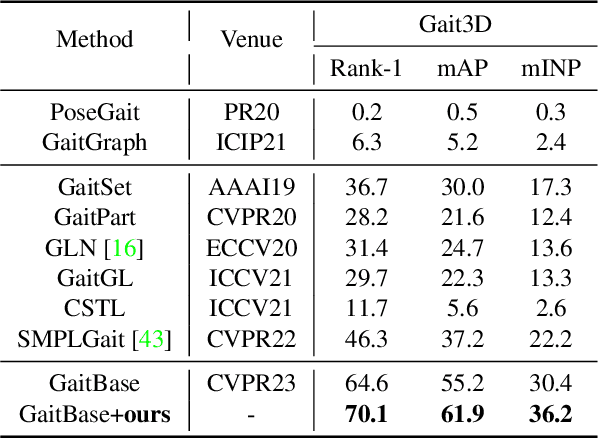
Abstract:Gait recognition is to seek correct matches for query individuals by their unique walking patterns. However, current methods focus solely on extracting individual-specific features, overlooking inter-personal relationships. In this paper, we propose a novel $\textbf{Relation Descriptor}$ that captures not only individual features but also relations between test gaits and pre-selected anchored gaits. Specifically, we reinterpret classifier weights as anchored gaits and compute similarity scores between test features and these anchors, which re-expresses individual gait features into a similarity relation distribution. In essence, the relation descriptor offers a holistic perspective that leverages the collective knowledge stored within the classifier's weights, emphasizing meaningful patterns and enhancing robustness. Despite its potential, relation descriptor poses dimensionality challenges since its dimension depends on the training set's identity count. To address this, we propose the Farthest Anchored-gait Selection to identify the most discriminative anchored gaits and an Orthogonal Regularization to increase diversity within anchored gaits. Compared to individual-specific features extracted from the backbone, our relation descriptor can boost the performances nearly without any extra costs. We evaluate the effectiveness of our method on the popular GREW, Gait3D, CASIA-B, and OU-MVLP, showing that our method consistently outperforms the baselines and achieves state-of-the-art performances.
 Add to Chrome
Add to Chrome Add to Firefox
Add to Firefox Add to Edge
Add to Edge